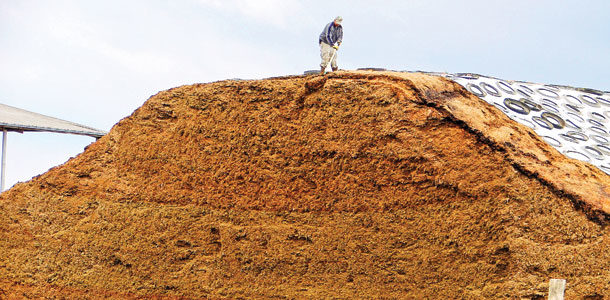Silage avalanches are real, and there is no way to predict when and where they will occur. It only takes a fraction of a second for part of a silage feedout face to silently break off and fall, and the result can be deadly for anyone beneath it. Recently, there have been numerous avalanche fatalities, including an 11-year-old boy in New Hampshire, a 19-year-old young man in New York, a 30-year-old truck driver in Idaho and a 63-year-old employee in Pennsylvania.
A Nebraska newspaper reported last October:
“A 53-year-old Norfolk man died Monday, October 21, 2013, in a feedlot accident. Stanton County Sheriff Mike Unger said Matthew Winkelbauer died after he was buried by a large silage pile that fell in an open silage pit at Four-Quarters Feedlot east of Norfolk.
Winkelbauer, who was the owner and operator of Four-Quarters, was pronounced dead at the scene. A co-worker was seriously injured in the accident that occurred about 3 p.m.”
We have been working the past 11 years with beef and dairy producers to help them implement safe, efficient and profitable silage programs.
Although rarely reported, we have listened to many stories about someone having a near miss or suffering a serious injury involving a silage avalanche. Examples include a nutritionist in California, a feedlot employee in Colorado, a nutritionist in Idaho and a nutritionist in Texas.
Tragedies happen all over the world. Last year we received this letter from Professor Ali Assadi-Alimouti, University of Tehran in Tehran, Iran, describing his serious injuries caused by a silage avalanche:
“It was March 15, 2010, and I went to see a large dairy farm client. Me and two of the herdsmen went to the large bunker silo (8,000 tons capacity). The height of the feedout face was about 20 feet. After visual appraisal of the silage, we were walking out of the bunker and a large silage avalanche fell on us.
Observers testified later that it was around 10 tons of silage. One of the herdsmen remained outside of the silage from his head, and thank God, he could call to other employees to come and save us. The worst injuries happened to me, including multiple fractures in my tibia and femur, and I was in a coma for 30 hours in the hospital.
The other herdsman suffered a broken leg and had respiratory problems due to inadequate oxygen for 10 minutes. I was the last one rescued, being trapped under the silage for about 20 minutes. It is by the grace of God that I am alive … God gave me another chance for life.”
One of the most common reasons for bunker and pile accidents is size and packing density; many are just too big to ever be safe for the crew filling the bunker or making the pile and the one feeding it out. Higher crop yields and growing herd sizes, which require more harvested acres, mean more silage needs to be stored.
But unless new bunkers are added, the footprint for drive-over piles is enlarged or packing density is increased significantly, there is nowhere for additional silage to go but up. As it does, so does the risk of an avalanche tragedy.
It is not uncommon for feedlots and large dairies to have bunkers and piles with silage faces that are 18 to 24 feet tall or taller. Common sense tells us that a 20-foot to 22-foot tall silage face is far more dangerous than one that is only 10 to 12 feet tall.
Unfortunately, the silage industry still has a long way to go to eliminate these senseless fatalities and serious injuries. Keep in mind, we cannot stop avalanches from happening, and they are impossible to predict … but we can prevent people from being under them.
Every farm, feedlot and dairy should have safety policies and procedures for their silage program, and they should schedule regular meetings with all their employees to discuss safety.
Here are guidelines that can decrease the chance of having a serious accident caused by a silage avalanche.
- Bunker silos and drive-over piles should not be filled higher than the unloading equipment can reach safely, and typically, a large unloader can reach a height of 12 to 14 feet.
- Use caution when removing plastic or oxygen-barrier film, tires, tire sidewalls or gravel bags near the edge of the feedout face.
- Do not “pitch” spoiled silage. It is simply too dangerous to remove surface spoilage from the top of many bunkers and piles.
- Use proper unloading technique, which includes shaving silage down the feedout face.
- Never “dig” the bucket into the bottom of the silage. Undercutting creates an overhang of silage that can loosen and tumble to the floor. This is a situation that is quite common when the unloader bucket cannot reach the top of an overfilled bunker or pile.
- Never drive the unloader parallel to and in close proximity of the feedout face.
- When sampling silage, take samples from a front-end loader bucket after it is moved to a safe distance from the feedout face.
- Never ride in a front-end loader bucket.
- Never park vehicles or equipment near the feedout face.
- Never allow people to approach the feedout face. No exceptions. A rule of thumb is never stand closer to the silage face than three times its height.
- Avoid being complacent. Always pay attention to your surroundings and never think that an avalanche cannot happen.
- Follow the “buddy rule” and never work in or near a bunker or pile alone. No exceptions.
- A warning sign, “Danger! Silage Face Might Collapse” should be posted around the perimeter of bunker silos and drive-over piles.
- If a bunker silo or drive-over pile is in a remote area on the farm, then the perimeter should be fenced and a sign posted, “Danger: Do Not Enter. Authorized Personnel Only.”
The number one priority is to send all employees home safe. If a silage program is not safe, then nothing else about it really matters at the end of the day. PD
For more information, contact Ruthie Bolsen by email or call (512) 301-2281.
Ruthie Bolsen is the managing director of Keith Bolsen & Associates. Keith Bolsen is a professor emeritus at Kansas State University.







